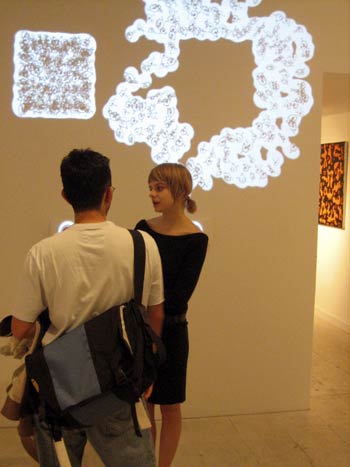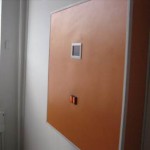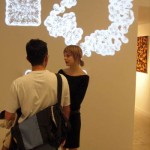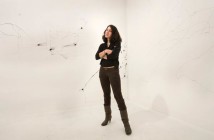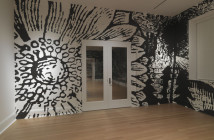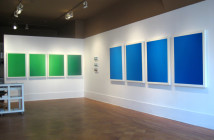I once attended a lecture where Zach Feuer, ex-Bostonian and proprietor of a number of galleries in NYC, spoke to an audience of 20 or so newbies about how to make it in our current art market. Now, my recollections of the lecture’s concept are very vivid, however, I can only paraphrase Feuer’s comments for I was nursing a hangover of Patagonian proportions. When asked about how to make it his answer came in the form of a short statement; “it’s the gang mentality”. The core of his 25 minute diatribe breaks down like this: You create a group of artists that are, for all intents and purposes, working with the same sense of self-importance. They must be artists with like minds, speaking a similar language, and using analogous visual components with intertwined concepts that relate; but are not identical. They are curating their own exhibitions; they can even go as far as opening up their own gallery. Sooner or later someone from the group breaks out, big time. With any luck, collectors, critics, Museums and everything else that comes with making it, is knocking on the door. A sweet theory; wouldn’t it be great if life was only a theory?
The exhibition Control, Option, Escape consists of seven artist; Mark Chariker, Nelson Da Costa, Reese Inman, Brian Knep, and Harvey Loves Harvey (Jason Dean and Matthew Nash). Throw in a wild card, or what the gallery calls its “Fresh Produce” artist, Kayla Pereira Risko, an artist chosen by the gallery, independently from the guest curator. As Magda Campos Pons (owner and founder) explained it, the gallery likes to keep a hand in the mix of the shows’ content.
Interestingly enough, one of the primary principles of GASP, is that the exhibition is curated by one of the artists involved. Curating an exhibition and also having work represented in that same exhibition can easily be seen as self-promotion. Whether or not the curator’s art work has merit can often become a secondary concern. To historically reinforce these concepts, the gang mentality theory and self-promotion, look at Damian Hirst’s ascent to notoriety. The exhibition Freeze, which was first conceived by the group Young British Artists (YBA) which included Hirst, in hindsight appears to have been a perfect platform for Hirst’s notorious self-promotion. This is not in any way a comparison of Hirst’s first show to Reese Inman’s curatorial endeavor Control, Option, Escape at Gallery Artist Studio Projects (GASP).
Of the 26 pieces shown, the level of the works ranged from the mature to the pubescent. The loosely developed theme of the show, an artistic response to the contemporary experiences of the media-information age, is straightforward enough to peak your curiosity and vague enough to include almost anything. Mark Chariker’s large scale anime oriented painting Even Though I Knew, I Said Nothing Because I Prefer Harmony is executed with the skill of a seasoned professional. Its repeating, flat, patterned background against generic anime characters and its op-art sensibility is interesting enough for a visual experience, but the content of his work reflects the attributes of his academic status.
Brian Knep’s interactive video installation Escape, which features the drawings of Emma B. Marlin-Curiel, age 4, is to react to the viewer’s presence though optic sensors. Unfortunately Knep’s video installation was on the fritz due to circumstances beyond everyone’s control. Knep’s piece was not functioning as conceived, even after a cool down and reboot. It’s important to note a collector had been at the gallery early in the day and was planning on purchasing the piece.
Reese Inman’s three serial paintings, Map I, Map II and Network II could have been the truest examples of this exhibition’s concept. Inman utilizes an industry standard 24” square panel as her starting point, then through the assistance of a computer and algorithms the composition is developed and completed. Her work is the most consistent and refined in the exhibition. The most evident quality in Inman’s painting is the absence of her hand, an inactive sense of application toward painting, which ties in nicely with her concept. The issue I have with Inman’s work is she goes to great lengths to remove the human aspect of painting from her art. So I’m puzzled to why she paints this pieces at all, maybe her concept would be better reinforced if she chose a different medium.
In the embryonic paintings by Nelson Da Costa, I’m vaguely reminded of Henri Matisse’s use of black as a formal hue. Da Costa is using the darkest value of his color palette and the negative space in his paintings to define his microbiological forms. The paintings rely on the tension created when an artist is playing heavily on the foreground-background relationships, and are very decorative. However, I believe that the paintings are contrived and rigid; over thought-out comes to mind. I can’t image how these embryonic forms, as an objective image, can exist in this picture plan, they seem to sit on top of the canvas and have little relationship to the space created in these paintings.
Harvey Loves Harvey’s An Interactive Exploration of the Response to the Random Increase or Decrease of Finances: Money Ain’t Nuthin', worked as intended. With its 2” LCD centered in a 36” square Day-Glo orange picture plane, two game show contestants within the LCD reacted to the viewer’s input; whenever the viewer pushed a corresponding button. I’m guessing that the scale of the LCD, and the overall size of the piece itself, is meant to draw you closer into the experience of interaction. I believe the scale and color choice are interesting conduits to guide the viewer/ user intuitively through the several staged reaction from the 2 game show contestants.
Fresh Produce Artist, Kayla Pereira Risko’s small scale drawings in the back of the gallery were what really caught my attention. At first I thought it was the relationship between the small room in which Risko’s eight pen and inks hung in regard to the physical dimension of her drawings (19” X 17”-21” X 17”). On closer inspection I realized that it was the illustrative quality in the pen and inks, in conjunction with a noticeable sense of intimacy that I truly appreciated in her work. I can’t honestly say I would have really noticed Risko’s drawings at any other exhibition if all the art work in the show wasn’t so decisive about the nature of itself.
The preoccupation with creating art in relation to the Now is a very slippery slope, which in my opinion is a fool’s errand. You are either making art or you’re not, and more often than not it’s determined by someone else. Everyone who plays this game understands that being talented is a plus, but it’s not a necessity to making it; who your friends are and which school you may have gone to is going to weigh far more heavily in your favor than how talented you are. I’ve witnessed so many artists rushing around trying to match their desire for success, with what they explain to me as their innate need to create works of art. I’m not buying it. Quite honestly, judging from this exhibition, it comes back down to the gang mentality. It’s evident that the exhibition’s premise, an artistic response to the contemporary experiences of the media information age, it’s meant to open enough for all sorts of interruptions. On one hand, only in this subjective realm of the arts can any of this have a sense of inherent wealth; I’m not referring to wealth as a monetary concept but as a sense of artistic value. On the other hand, something happens to art, and or maybe the artist, when they try creating on the edge of history.
Links:
Gallery Artist Studio Projects (GASP)
"Control, Option, Escape" is on view until December 2nd at GASP, located at 362-4 Boylston Street Brookline, MA.
All images are courtesy of the artists and GASP

